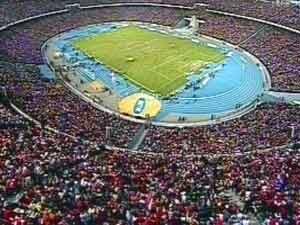 The year 2010 has seen Egypt celebrate three strongholds of progress and development in its modern history. It has been 50 years since the first spark which marked the beginning of the construction of the Aswan High Dam; 50 years on the establishment of the first Egyptian national TV channel; and 50 years since the erection of the Cairo stadium. All three national projects have positively affected the life of Egyptians in an irrevocable manner. Precisely for this reason, it is time to assess what each has achieved in terms of ameliorating the life of Egyptians. While the first two projects have had their fair share of appraisal by the media, I intend to focus on the third project.
The year 2010 has seen Egypt celebrate three strongholds of progress and development in its modern history. It has been 50 years since the first spark which marked the beginning of the construction of the Aswan High Dam; 50 years on the establishment of the first Egyptian national TV channel; and 50 years since the erection of the Cairo stadium. All three national projects have positively affected the life of Egyptians in an irrevocable manner. Precisely for this reason, it is time to assess what each has achieved in terms of ameliorating the life of Egyptians. While the first two projects have had their fair share of appraisal by the media, I intend to focus on the third project.
Cairo Stadium and its [desolate] sisters
Youseef Sidhom
Opinion
00:09
Sunday ,12 September 2010
![Cairo Stadium and its [desolate] sisters](Uploads/258/FA912.jpg)
My generation bears fond memories of the Cairo Stadium. We lived through its construction and spectacular opening; were infatuated with the huge array of sports events, youth festivals and games it hosted; and felt pride and honour at being part of the country which built such a magnificent edifice.
Many Egyptians, however, do not know that Cairo Stadium—no matter how wonderful it may appear—was never designed to be the end of the tale. It was a mere first step in a project which was to be a world class Olympic Village and Fair Ground. Slowly but surely, a large portion of the original plan was accomplished; the 1980s saw the opening of the Olympic swimming pool as well as the open air arena for sports and theatre, while the covered sports arena and the tennis and squash court complex were opened in the late 1990s.
Today, it is obvious that only Cairo Stadium is being utilised to its full capacity, and is being regularly maintained in excellent shape. This is not surprising given the fact that it is a major venue for football games, football being the national popular sport. The covered arena comes in a close second, with the numerous games and events it hosts. In stark contrast, we very rarely hear of events held in the swimming stadium, the open air arena, or the squash courts which appear to have fallen into disuse after the modern glass courts at the Giza pyramids and Hurghada stole the squash game lights.
The end result is a picture which generates nothing but frustration. The hundreds of millions of Egyptian Pounds spent on superb sports facilities appear to have been poured down the drain. The disuse of any facility leads to no maintenance and sparse renovation, and is the devil which ultimately destroys it. The question which now begs an answer is whether the State sports authorities had—or have—any plan to make good use of the Cairo Stadium sports facilities, whether through official or commercial activities. Why are water sports events in swimming, diving, water polo, or synchronised swimming not held there? To say nothing of other sports activities including handball, basketball, volleyball, or tennis. Is there no State department—the Central Accounting Authority, say—that ever did, or may now conduct a feasibility study to show how little return Egypt is getting on its huge investment in these unused sports facilities? And would such a study push the State sports authorities to revise their policy of ignoring their adequate exploitation?
My almost-daily route from home to work takes me past the open air arena and the swimming stadium. A few days ago I noticed the arena was floodlit, an event so unusual, it directly aroused my interest. I wondered whether it was hosting some Ramadan event and would soon go back to its invariable dark, or if this signalled a new breath of life for an old, all but forgotten project.
With half-a-century today since the Cairo Stadium ambitious project sparked off, it is time we contemplate—and act towards salvaging—the hundred-millions-Pounds worth of property and facility we are wasting.



